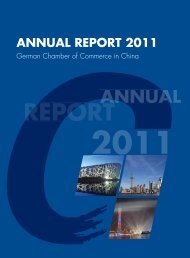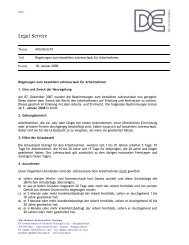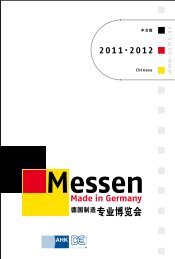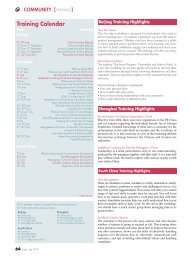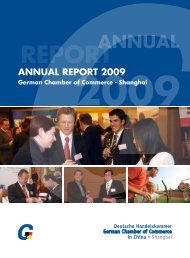Minister Steinmeier - AHKs
Minister Steinmeier - AHKs
Minister Steinmeier - AHKs
You also want an ePaper? Increase the reach of your titles
YUMPU automatically turns print PDFs into web optimized ePapers that Google loves.
Business Focus<br />
Xi’an - North China<br />
Xi’an – More than history<br />
To most people Xi’an, capital of Shaanxi province, is best known as the<br />
cradle of Chinese culture and a tourist destination where they can visit<br />
the relics of the ancient capital Chang An, of which the Terracotta Warriors,<br />
the City Wall, Drum Tower, Bell Tower and the two Wild Goose<br />
Pagodas are best known. The economic relevance and potential of the<br />
city in modern times, however, is widely underestimated.<br />
Xi’an was approved by the<br />
State Council to be an<br />
inland opening city in 1992<br />
and a comprehensive reform<br />
test city in 1994, which<br />
made it a key city in West<br />
China and led to its recognition<br />
as “The most innovative<br />
and vigorous city in<br />
the world” by the United<br />
Nations Industrial Development<br />
Organization (UNIDO)<br />
in 2002. The West China Development Strategy was implemented comprehensively,<br />
so that the infrastructural premises today surpass those<br />
of most central Chinese cities and still continue to improve.<br />
While its economical supremacy is unchallenged in the northwest<br />
region (i.e. the provinces of Shaanxi, Gansu, Xinjiang, Qinghai and<br />
Ningxia), Xi’an competes with neighbouring Sichuan´s capital Chengdu<br />
and Chongqing in the southwest to attract foreign investment. All<br />
three cities benefit from their central location and offer ready access<br />
August - September 2008 | 16<br />
The German Chamber of Commerce in China<br />
to the domestic market. For Xi’an it is 600m consumers and 10 provincial<br />
capitals within 12 hours´ travel time. Regarding export, Xi’an is<br />
connected to the east coast seaports in the Bohai area. As the largest<br />
transportation hub in northwest China, Xi’an has formed a network<br />
of high-level highways, railways and aviation stretching in all directions.<br />
A major advantage for Xi’an is its role as a logistics hub on the<br />
Eurasia rail link, which gives access to the Central Asian Republics, a<br />
connection of growing significance, as the ties to the growing markets<br />
in Central Asia and Russia among others are tightened by the bian-<br />
nual Euro-Asia Forum of the Shanghai Cooperation Organisation (SCO),<br />
which is also held in Xi’an. Due to its history as a center for research<br />
and production of military technology, Xi’an has become an important<br />
base of higher education with more than 80 public and private universities,<br />
providing companies with a deep pool of talents. For example,<br />
Jiaotong University In Xi’an is one of the few Top 10 Universities in<br />
China outside Beijing and Shanghai.<br />
The city uses a system of “Four Zones and Districts, one Base” to<br />
develop the six key industries of high technology, equipment manufacturing,<br />
tourism, cultural industry, modern services and software. Backbone<br />
of the high-tech industry are bio-medicine, electronic information,<br />
optical-mechanical-electrical integration, photoelectron, aviation<br />
and space flight, new materials and high efficiency and energy saving<br />
environmental protection industry. Main traditional industries in Xi’an<br />
are equipment manufacturing, light textile industry, chemical industry,<br />
food and beverage and building materials. The four zones and districts<br />
and one base are namely the Xi’an Hi-tech Industries Development<br />
Zone (XHTZ), Xi’an Economic and Technological Industries Development<br />
Zone (ETDZ), Qujiang New District, Chanba Ecological District<br />
(CBE) and Yanliang Aviation Hi-tech Industries Base (CAIB).<br />
For the future the Urban Development Plan of Xi’an is designed to<br />
lower residential density in the city center adding satellite cities<br />
outside the Third Ring Road and to establish an industrial region<br />
in the west, an economic region in the north, a region for tourism<br />
in the east and a leisure and resort region in the south of the presently<br />
developed areas. On a provincial level the expanded Xi’an will<br />
be the center on an east-west-axis along the Longhai Railway and the<br />
Baotong Highway (“One line and two belts”) from Baoji through Yangling,<br />
Xianyang, Xi’an, Weinan to Tongguan, forming the Guanzhong<br />
National Hi-tech Industries Belt, named after the Guanzhong plain<br />
where the cities are situated.<br />
Axel Brost | Managing Director - China Consulting Service Ltd.<br />
Jinyu Huayuan 3252 | No. 63 Xiying Lu | Xi’an 710054<br />
Tel: 013 9911-74967 | Email: axel.brost@china-consulting-service.com<br />
| Web: www.china-consulting-service.com




